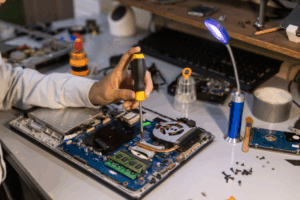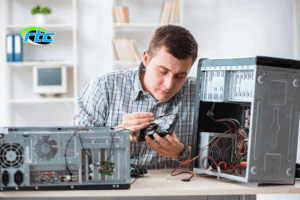Ethernet cabling is the backbone of wired networks. Whether it’s your home internet setup or a complex business infrastructure, the quality and condition of your Ethernet cables play a critical role in maintaining speed, stability, and security. Yet, many people overlook the health of their cabling—until network performance starts to decline.
So, how long do Ethernet cables really last? And what are the signs that it’s time to replace them?
This in-depth guide covers:
- Lifespan of different types of Ethernet cables
- Key factors that affect cable longevity
- Warning signs of aging or damaged cables
- Tips to extend the life of your cabling
- When and why you should consider upgrading
Understanding the Role of Ethernet Cabling in Modern Networks
Ethernet cabling facilitates the physical connection between network devices such as modems, routers, switches, and endpoints (like PCs, printers, IP cameras, or VoIP phones). While Wi-Fi has become popular for its convenience, Ethernet is still the gold standard for:
- Low-latency applications like gaming and video conferencing
- Consistent speeds for file transfers or cloud backups
- High-performance office networks and server rooms
- Environments where security and EMI resistance are essential
Because Ethernet cables serve as the transmission path for your data, any degradation in their quality directly affects your network’s performance.
Average Lifespan of Ethernet Cables
General Rule of Thumb
Most Ethernet cables, when installed correctly and used under ideal conditions, can last 10 to 20 years. Some shielded and industrial-grade cables may last even longer, especially if installed in a controlled environment like a server room or structured cabling system.
However, cables exposed to physical or environmental stress may require replacement much earlier.
Lifespan by Cable Type
| Cable Type | Bandwidth | Use Case | Lifespan |
|---|---|---|---|
| Cat5 | Up to 100 Mbps | Obsolete in 2025 | 10–15 years |
| Cat5e | Up to 1 Gbps | Basic home/office setups | 15–20 years |
| Cat6 | Up to 10 Gbps (short) | Modern LANs, file sharing, video calls | 15–20 years |
| Cat6a | Up to 10 Gbps | High-speed business or enterprise use | 20–25 years |
| Cat7/Cat8 | 10–40 Gbps | Data centers, financial institutions | 25+ years |
⚠️ Important: Just because a cable works doesn’t mean it’s delivering optimal performance. Outdated cables can become a bottleneck for high-speed internet connections or modern devices.
Factors That Impact Ethernet Cable Longevity
1. Installation Quality
Poor installation practices are one of the top reasons Ethernet cables fail prematurely:
- Sharp bends and over-tightened cable ties can damage internal wiring.
- Inadequate cable support in ceilings or walls can cause sagging and stress.
- Exceeding maximum run lengths (100 meters for most twisted-pair cables) can degrade signal quality.
2. Environmental Conditions
- Moisture and humidity can lead to corrosion inside the cable.
- UV radiation from sunlight can cause jackets to crack or become brittle.
- Temperature extremes can expand and contract the cable jacket, causing microfractures over time.
- Pests like rodents can chew through cables, especially in attic or crawlspace installations.
3. Mechanical Stress
Ethernet cables subjected to frequent motion—like in industrial machinery or desk setups with moving furniture—can suffer from internal wire fatigue.
4. Electromagnetic Interference (EMI)
Unshielded cables run alongside power cables or near heavy machinery may experience signal interference, resulting in slower speeds or packet loss. Over time, this exposure can damage cable shielding or reduce transmission quality.
How to Know When It’s Time to Replace Your Ethernet Cables
Here are specific indicators to look for:
1. Consistently Slow Network Speeds
If you’re paying for high-speed internet but still experiencing lag or slow file transfers, your cables could be the limiting factor—especially if they’re Cat5 or Cat5e.
2. Intermittent Connectivity
Frequent disconnects, fluctuating signals, or dropped Zoom calls may stem from internal cable faults or damaged connectors.
3. Visible Damage
Look for signs such as:
- Cracked or brittle insulation
- Bent or corroded connectors
- Frayed or exposed wires
Even small damages can lead to performance issues or safety hazards.
4. Using Obsolete Cable Standards
If your infrastructure still relies on Cat5 or early Cat5e cables, it’s time to upgrade. These cables were never designed to handle modern bandwidths, particularly in environments with multiple devices streaming, gaming, or uploading content.
5. Planned Hardware Upgrades
If you’re installing:
- A new high-speed router or managed switch
- Fiber internet
- 4K security cameras or VoIP systems
You should upgrade your Ethernet cabling to at least Cat6 or Cat6a to ensure compatibility and performance.
Best Practices for Extending Cable Lifespan
To get the most out of your Ethernet investment:
1. Use the Right Cable for the Right Environment
- Outdoor runs should use weatherproof and UV-rated cables.
- Plenum spaces (e.g., HVAC areas) require plenum-rated cables that are fire-resistant and low-smoke.
- Use shielded twisted pair (STP) cables in high-interference areas like industrial settings.
2. Install with Proper Cable Management
- Avoid tight bends (never below the cable’s bend radius).
- Use cable trays, conduits, and Velcro ties rather than plastic zip ties.
- Label cables for easier troubleshooting and upgrades.
3. Don’t Exceed Maximum Length
- For standard Ethernet: 100 meters (328 feet) is the max recommended run.
- For longer runs, consider switches or powered extenders to boost signal.
4. Keep Connectors Clean and Secure
Dirty or oxidized RJ45 connectors can weaken the connection, even if the cable is intact. Use dust caps or cover plates for rarely used ports.
When to Upgrade Instead of Just Replace
Even if your Ethernet cables aren’t damaged, upgrading them may unlock performance improvements:
| If You Are | Upgrade To |
|---|---|
| Using Cat5 or Cat5e | Cat6 or Cat6a |
| Running 4K cameras or VoIP systems | Cat6a or Cat7 |
| Installing 10 Gbps+ networks | Cat6a or Cat8 |
| Operating in high-EMI areas | Shielded Cat6a or Cat7 |
Also consider replacing patch cables and wall jacks to ensure end-to-end compatibility with faster speeds.
The Cost of Waiting Too Long
Outdated or failing Ethernet cables can lead to:
- Network downtime or outages
- Reduced productivity in business environments
- Security risks if the network becomes unstable or vulnerable
- Expensive troubleshooting and reinstallation when failure is unplanned
Planning proactive upgrades minimizes disruption and helps ensure your network remains reliable, efficient, and scalable.
Conclusion
Ethernet cabling may not be the most visible part of your IT setup, but it plays a critical role in keeping your network stable and fast. While quality cables can last up to 20 years, performance requirements, damage, or improper installation can shorten their usable life. Whether you’re experiencing slow connections or planning a tech upgrade, inspecting and possibly replacing your Ethernet cabling could make a significant difference.
Professional Cabling Services You Can Trust
At Reliable Telecom, we specialize in:
- Structured cabling installation
- Cable testing and diagnostics
- High-speed network upgrades
- Commercial and residential Ethernet solutions
Schedule a consultation today to ensure your network cabling supports your current and future needs—efficiently and affordably.



